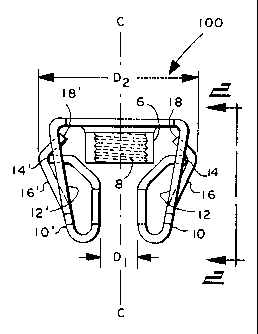Some of the information on this Web page has been provided by external sources. The Government of Canada is not responsible for the accuracy, reliability or currency of the information supplied by external sources. Users wishing to rely upon this information should consult directly with the source of the information. Content provided by external sources is not subject to official languages, privacy and accessibility requirements.
Any discrepancies in the text and image of the Claims and Abstract are due to differing posting times. Text of the Claims and Abstract are posted:
| (12) Patent: | (11) CA 2257062 |
|---|---|
| (54) English Title: | THREADED NUT EXPANSION FASTENER |
| (54) French Title: | PIECE DE FIXATION EXPANSIBLE A ECROU FILETE |
| Status: | Term Expired - Post Grant Beyond Limit |
| (51) International Patent Classification (IPC): |
|
|---|---|
| (72) Inventors : |
|
| (73) Owners : |
|
| (71) Applicants : |
|
| (74) Agent: | BORDEN LADNER GERVAIS LLP |
| (74) Associate agent: | |
| (45) Issued: | 2008-04-15 |
| (22) Filed Date: | 1998-12-30 |
| (41) Open to Public Inspection: | 1999-07-22 |
| Examination requested: | 2003-07-31 |
| Availability of licence: | N/A |
| Dedicated to the Public: | N/A |
| (25) Language of filing: | English |
| Patent Cooperation Treaty (PCT): | No |
|---|
| (30) Application Priority Data: | ||||||
|---|---|---|---|---|---|---|
|
A barrel nut type fastener (100) is provided for securement within an opening (20) to a panel ("P") by a threaded member ("T") that when rotationally advanced through the barrel nut causes free-ends (14) and (14') of resilient legs (10) and (10') to move away from each other and respectively engage and urge resilient fingers (16) and (16') into contacting engagement with opposite sides of opening (20) with sufficient force to secure fastener (100) to panel, ("P").
Cet extrait concerne un écrou à portée cylindrique (100) qui doit être assujetti dans l'ouverture (20) d'un panneau (P) au moyen d'un élément fileté (T) qui, lorsqu'il est vissé dans l'écrou à portée cylindrique, écarte les extrémités libres (14 et 14') de jambes plastiques (10 et 10') l'une de l'autre et engrène respectivement des doigts plastiques (16 et 16') qui sont ainsi mis en contact avec les côtés opposés de l'ouverture (20) avec suffisamment de force pour attacher la pièce de fixation (100) au panneau (P).
Note: Claims are shown in the official language in which they were submitted.
Note: Descriptions are shown in the official language in which they were submitted.

2024-08-01:As part of the Next Generation Patents (NGP) transition, the Canadian Patents Database (CPD) now contains a more detailed Event History, which replicates the Event Log of our new back-office solution.
Please note that "Inactive:" events refers to events no longer in use in our new back-office solution.
For a clearer understanding of the status of the application/patent presented on this page, the site Disclaimer , as well as the definitions for Patent , Event History , Maintenance Fee and Payment History should be consulted.
| Description | Date |
|---|---|
| Inactive: Expired (new Act pat) | 2018-12-30 |
| Letter Sent | 2010-01-04 |
| Letter Sent | 2010-01-04 |
| Letter Sent | 2010-01-04 |
| Grant by Issuance | 2008-04-15 |
| Inactive: Cover page published | 2008-04-14 |
| Pre-grant | 2008-01-29 |
| Inactive: Final fee received | 2008-01-29 |
| Notice of Allowance is Issued | 2007-08-15 |
| Letter Sent | 2007-08-15 |
| Notice of Allowance is Issued | 2007-08-15 |
| Inactive: Approved for allowance (AFA) | 2007-07-31 |
| Amendment Received - Voluntary Amendment | 2006-12-29 |
| Inactive: S.30(2) Rules - Examiner requisition | 2006-06-29 |
| Inactive: Office letter | 2005-02-24 |
| Letter Sent | 2005-02-23 |
| Inactive: Single transfer | 2005-02-23 |
| Letter Sent | 2005-02-23 |
| Inactive: Office letter | 2004-12-10 |
| Inactive: Single transfer | 2004-12-07 |
| Letter Sent | 2004-12-07 |
| Letter Sent | 2004-12-07 |
| Letter Sent | 2004-12-07 |
| Letter Sent | 2004-12-07 |
| Inactive: Office letter | 2004-12-07 |
| Inactive: Single transfer | 2004-12-07 |
| Inactive: Single transfer | 2004-12-07 |
| Inactive: Multiple transfers | 2004-11-02 |
| Letter Sent | 2003-08-27 |
| Request for Examination Received | 2003-07-31 |
| Request for Examination Requirements Determined Compliant | 2003-07-31 |
| All Requirements for Examination Determined Compliant | 2003-07-31 |
| Letter Sent | 2002-01-30 |
| Inactive: Office letter | 2002-01-30 |
| Letter Sent | 2002-01-30 |
| Letter Sent | 1999-10-20 |
| Inactive: Office letter | 1999-10-20 |
| Letter Sent | 1999-10-20 |
| Inactive: Multiple transfers | 1999-08-31 |
| Inactive: Multiple transfers | 1999-08-31 |
| Inactive: Multiple transfers | 1999-08-31 |
| Inactive: Cover page published | 1999-07-27 |
| Application Published (Open to Public Inspection) | 1999-07-22 |
| Inactive: Correspondence - Formalities | 1999-03-30 |
| Inactive: IPC assigned | 1999-02-15 |
| Inactive: IPC assigned | 1999-02-15 |
| Classification Modified | 1999-02-15 |
| Inactive: First IPC assigned | 1999-02-15 |
| Filing Requirements Determined Compliant | 1999-01-29 |
| Application Received - Regular National | 1999-01-29 |
| Inactive: Filing certificate - No RFE (English) | 1999-01-29 |
There is no abandonment history.
The last payment was received on 2007-12-05
Note : If the full payment has not been received on or before the date indicated, a further fee may be required which may be one of the following
Please refer to the CIPO Patent Fees web page to see all current fee amounts.
Note: Records showing the ownership history in alphabetical order.
| Current Owners on Record |
|---|
| A. RAYMOND ET CIE |
| Past Owners on Record |
|---|
| JAMES RICHARD MUMBY |
| MICHAEL RICHARD DANBY |